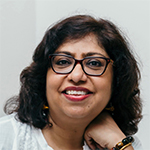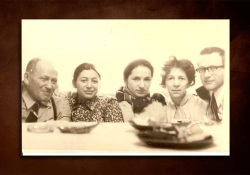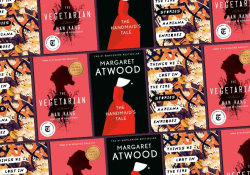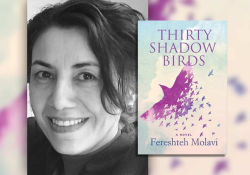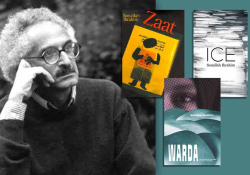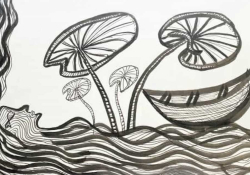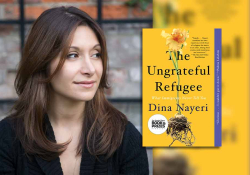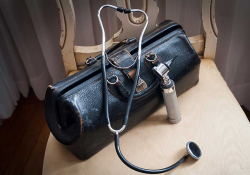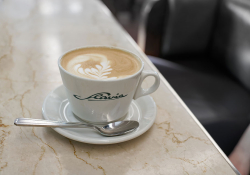Singing about the Coronavirus Using an Ancient Art Form: The Patuas of Bengal
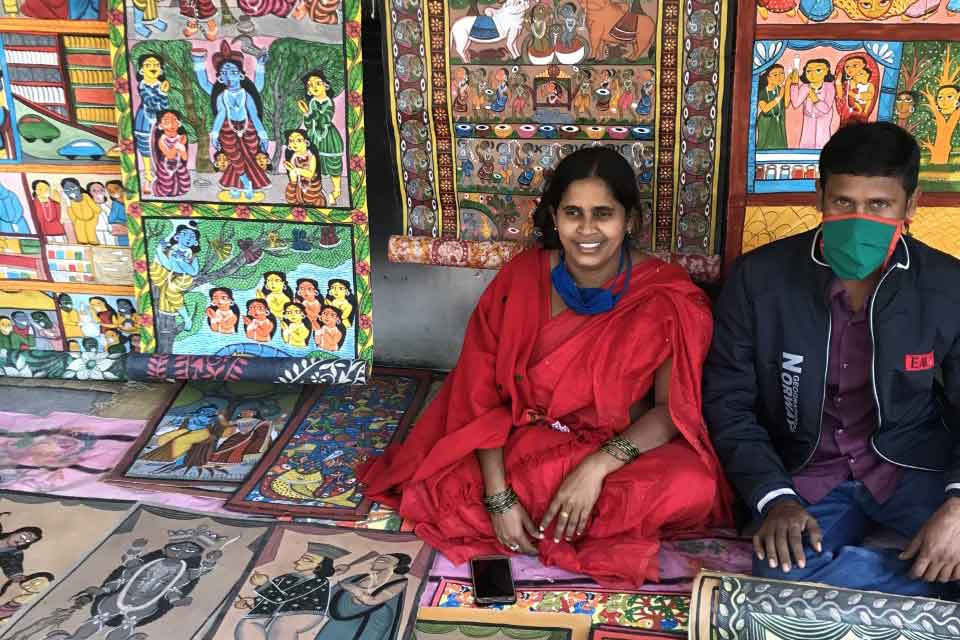
How can a Patua artist like Susama, with a painted paper scroll and a song on her lips, compete with the streaming services providing nonstop entertainment on television or the Bollywood extravaganza with CGI graphics enhancing storytelling? Travel to Pingla with Dipika Mukherjee and meet the artists practicing this ancient art form, which tackles social issues in a way that can be understood by some of the poorest and most marginalized populations in our world.
“Didi”—the driver addresses me as Elder Sister—“if you had come even two weeks ago, you would have seen our fields all golden with wheat. Our land is so beautiful.”
I am on my way to Pingla, home to about eighty-five families of Patachitra painters or Patuas, artisans practicing an ancient art form by painting stories in a series of frames on long scrolls of cloth. As they unfurl the scrolls, they sing the stories.
The village is 130 kilometers from Kolkata by road, and I am with Susama Chitrakar—the last name Chitrakar is a family surname that indicates one who makes art—a Patachitra artist who now specializes in painting on social issues. If there is flooding in the Bay of Bengal, or a need to spread awareness about HIV/AIDS, Susama works with an NGO to get the message to the most impoverished and illiterate parts of rural West Bengal. Artists like Susama don’t have showrooms or websites and are struggling through the pandemic, yet they continue to create astonishing work; her talent has been recognized by the Indian government and her work displayed in exhibitions as far away as Norway and China.
She is part of this unique tribe of folk artists who paint pictures, make up lyrics to songs to accompany the images, then perform, sometimes in front of crowds, sometimes singing to a single person. They are equally at ease narrating mythological stories from Indian epics like the Ramayana or singing stories from community lore. In these times, when social messages on the pandemic are a priority, they have quickly adapted, painting stories of hospitals and vaccination needles in a series of frames on long scrolls, like large-print comic books without the text.
Susama is taking me to show me her village and the process of her art. I am interested in seeing how the vivid colors are made, especially as the paint she uses is foraged from the land she lives on.
I met Susama at the Crafts Museum in New Delhi in November 2020, two years ago, where she was trying to sell her art at a time when pictures seemed frivolous as sirens screeched through the world’s cities, including outside on the roads of Delhi, ferrying the sick and the dying. Susama sat surrounded by a wallpaper of scrolls in a stall made to replicate a mud hut, and in that small space, colors bloomed into the mythology of Hindu gods, Buddhist animal tales, and Bengali fish marriage motifs.
She turned a scroll around to show me the patterned cotton of a recycled sari on the other side. Then she burst into song.
Ei ki bhoyonkoro holo re coronavirus, ei ki bhoyonkoro!
Coronavirus namey shunini kokhono, ei ki bhoyonkoro!
How frightening is this coronavirus, so frightening!
Never heard of coronavirus before, yet so frightening!
As Susama sang, she rolled the scroll downward, covering over the part that looked like a demon—a Rakshash—with gaping mouth swallowing tiny humans. She then pointed to a picture of a TV set, with masked doctors milling around:
TV te joto dekhi toto praney lagey bhoi, ei ki bhoyonkoro!
Boro daktarbabu kabu hoye jai, ei ki bhoyonkoro!
The more I watch TV, the more terrifying it is, so frightening!
The skilled doctors are felled by this, so frightening!
When she sang about the need to wash hands frequently with soap, the picture she pointed to was not a tap but a hand pump. The rural villages of West Bengal are one of the poorest areas in South Asia, and there is a shortage of clean and safe drinking water, with people reliant on nearby ponds for drinking, cooking, bathing, washing, and other day-to-day activities. During the monsoons, water in these small ponds becomes even more unsafe and causes many illnesses.
Susama’s full-throated song about the need for masks and distancing was astonishing in its modern references, for she was using the tune and couplets of oral singers, at times replicating the repetitive couplets of religious bhajans. The genre would be familiar to Indians, but her message was startlingly topical.
Susama’s full-throated song about the need for masks and distancing was astonishing in its modern references.
I sat mesmerized by her cinematic presentation and the ease with which she delivered it so fluently, like a rap artist needing nothing written to perform, and sometimes even riffing. We had started to chat in Bengali, as I had seen the prominently displayed sign explaining that she was an artist from West Bengal.
After the coronavirus scroll, she unfurled one with goddesses and sang a paean to the goddess Durga, surrounded by the goddesses Kali, Lakshmi, and Saraswati, a pantheon most beloved in Bengal. It was clearly a practiced spiel for a Bengali tourist, but I was still riveted by her coronavirus scroll. I asked about the paints used, the recurring religious iconography in her scrolls, the similarity to the Kalighat style of painting favored by the British when India was the jewel in the crown. Susama urged me to visit Pingla to see how these scrolls are made, handing me her telephone number to keep in touch. “Come in November next year,” she said. “We have the Pot Mela, and the whole village becomes an open-air art gallery!”
* * *
Two years would pass before the pandemic would ease enough to allow me to visit her artisanal village, but finally, in May 2022, I am in a car hired from Kolkata, with Susama by my side.
In the morning, I wake up to views of trees pregnant with bright red lychees next to verdant banana leaves curving their graceful stems over the pond. A bright orange duck shack is identifiable in large English and Bengali script as Hash Ghor and Duck House. A yellow swing waits in the garden.
I stay at the only hotel in the area, listed as a Bagan-Bari, literally translated as Garden-Abode. It is basic but set in a picturesque landscape. The motorized TOTO—battery-operated rickshaw—waits for me as breakfast is served, a languid, slow preparation, as everything on my plate is harvested from the land around us—including the duck-egg omelet.
My host is curious about why I want to see the Chitrakars. He has retired to this bucolic life after a successful career in Kolkata and slowly sips his milky tea, indifferent to time passing.
“You have to understand,” he begins, “these artists, even ten years ago, were selling pictures on the street, at traffic junctions, street corners. No one wanted to buy their stuff. Then the government money started to come in. Once they were begging people to buy their art, now people come from overseas and they peddle everything to tourists like you.”
I nod. I already know the artisans make a range of products beyond the scrolls, as I bought T-shirts and face masks and items for home décor with Patachitra motifs from Susama in Delhi. Patachitra received the Geographical Indication (GI) tag, and the government of West Bengal’s Department of Micro, Small, and Medium Enterprises & Textiles, in association with UNESCO, developed a rural craft hub in Pingla.
“Their fortunes changed so fast,” my host muses. Then he uses a word I haven’t heard used in speech: “these people, you know, are Mohammedans.”
And there it was. His surname identified him as a Bengali Hindu, and mine, as in much of India, gave away my caste, religion, and the region of a (patriarchal) lineage. He was suggesting a solidarity in a sharply divided India, where minorities were under the threat of the growing Hindutva movement. Muslims were the most vilified and frequently thought to take more Indian largesse than was their due.
He was suggesting a solidarity in a sharply divided India, where minorities were under the threat of the growing Hindutva movement.
When I first spoke to Susama in Delhi, we did not speak of her religion at all; her art seemed beyond religion, especially as the message was about a pandemic that was killing so many, all around the world. Despite the majority of her iconography being Hindu, her religion seemed irrelevant to me.
Yet so much about what the Patuas like Susama do is inextricably weighed down by religion, and it has been so for a long time. Susama’s family is Muslim. Patuas can be Hindus or Muslims, and all practice customs that are both Hindu and Islamic in nature, and these communities are found in neighboring Bangladesh as well as in many eastern Indian states including West Bengal. Like many heritage artisanal communities, they are often impoverished and rely largely on Hindu patronage, or from selling art as tourist souvenirs. Many are being forced into jobs as daily wage laborers, or factory workers, leaving them no time for their art.
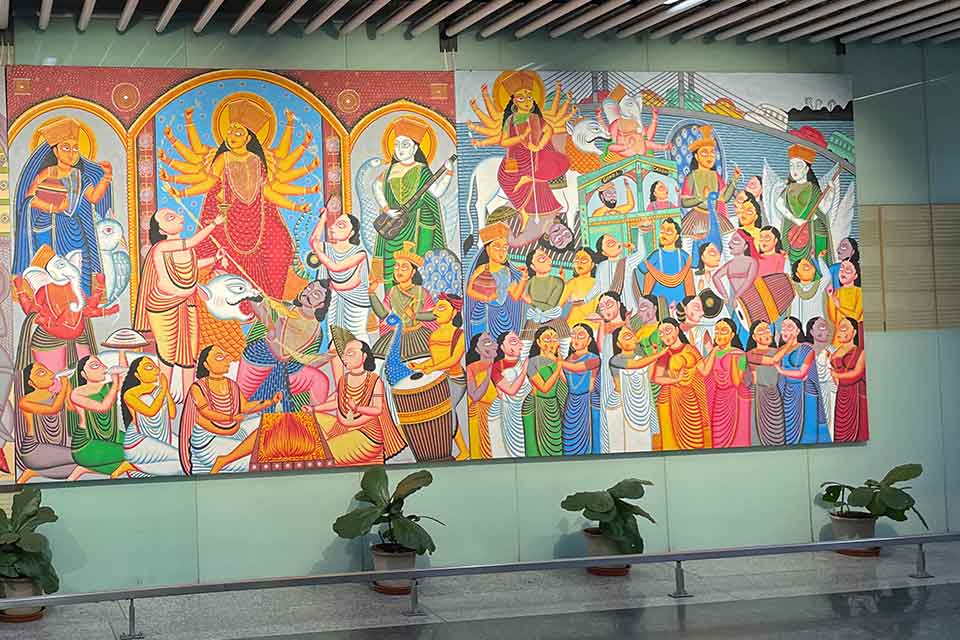
Although the precise origin of this art form is undocumented, Chitrakars and their art form can historically be traced back to the thirteenth century. Some Chitrakars claim an ancestry that stretches to the artists of cave paintings in the region. The skill of Patachitra is the pride of Bengal; on arrival at the Kolkata airport, people see a huge mural in this style, and the heritage hotel I stayed at had a room styled in this art form.
The Patua have been a part of Bengal as a unique community that speaks to the diversity at the heart of India. Although their traditional occupation is the painting of Hindu idols, many of them are Muslims and widely known as Chitrakar, which literally—only—denotes a scroll painter. Emblematic of the cross-pollination of centuries, Patuas are mentioned in Hindu, Buddhist, and Islamic historical texts, their faith as porous as the art they created.
Like many other artisan groups in India, a decline in their traditional occupation means that more are being forced into jobs as daily wage laborers or factory work.
Often a Patua has two names, one Hindu and one Muslim. When I finally reach Susama’s home and she introduces her children to me, her three daughters have Bengali names, unmarked by religion. Only her son introduces himself with a clearly Muslim name.
* * *
The walls pop with color as Susama bustles about her home, bringing me teapots with fish motifs, small wooden decorated trays, stationery items, even a hand-painted wedding sari. I am given a mora to sit on, a traditional stool handwoven from bamboo reeds. Susama lives in this home with her four children, her husband, and both her parents.
Her father tells me about generations of his ancestors being scroll painters or Patuas, how they traveled like wandering minstrels selling their scrolls and singing stories in return for a cup of rice, some lentils, maybe a bit of a vegetable, or, on good days, a coin or two. He tells me about the popular religious stories such as the medieval mangal poems and how his work has promoted literacy in surrounding villages.
Father: There are three kinds of light in this world. The light of the sun and the moon, we see that every day, but there is a light within us that is also necessary to illuminate the world.
Me: Light within us?
Father: You know who Kalidas was?
Me: My father was named Kalidas, after the most famous ancient Indian poet and playwright . . . yes, I know.
Father (pointing to his picture): This is Kalidas, this is Saraswati. Kalidas was an illiterate thug, but then he learned how to read and write and went on to write marvelous literature like . . .
Me: . . . Shakuntala!
Father: Yes! The next picture is of illiterate village folk, picking up notebooks. Then the final picture is of them learning to write. I use this in villages; I sing about Kalidas, to promote literacy, to show anyone can learn.
Me: Wonderful!
Father: I do it to spread the light. Within all of us. Wherever you can, spread the light.
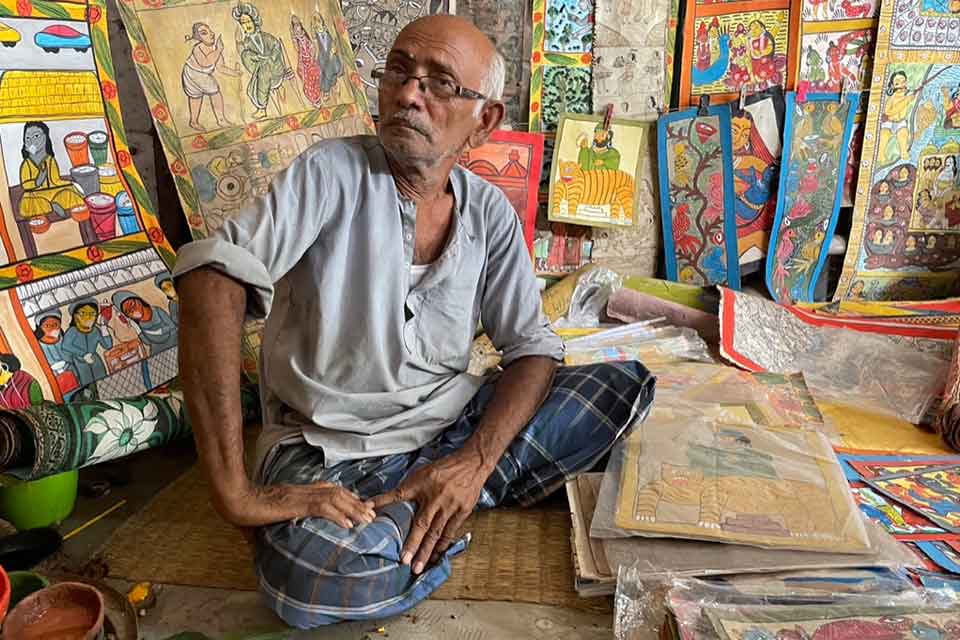
Her father’s scroll has three parts, and the lines are sparse, the characters alike in face and form. Susama’s work is much more detailed, clearly more sophisticated in the use of color and the complexity of recurring motifs within the same painting. But her father is the patriarch who takes center stage, displaying his art, his certificates, even his work bag, and only after he is finished do Susama and her mother show me their other work and sing together, unfurling a charming painting about a fish wedding.
Her mother, Susama happily says, is the best writer of lyrics.
Her mother tells me that Susama is the best painter in the family.
There is an easy repartee between the two; Susama tells me that it was her mother, Rani, who gave her the idea to draw the first coronavirus scroll, so that doctors could display them in clinics. It is Rani Chitrakar who is now teaching her sixteen-year-old granddaughter about lyrics and song.
From the time she was five years old, Susama started to draw and sing with her parents. Her grandfather was a painter, and he learned from his forefathers, and so it had been, always, in the family. I look at the children, the daughters huddled together. What about the next generation? The girls?
The eldest daughter, at eighteen, is already an accomplished artist. The next one, at sixteen, is still learning, and the seven-year-old is a beginner.
“What about your son?” I ask. “Would you prefer him to train for another trade?”
In her answer, Susama emphasizes the words Bongsher Porompora—it is a family tradition. Her son will also be an artist. “Etai amader jibika,” she says. “It is our vocation.”
Of course, continues Susama, the pandemic took away their earnings, kichu chilo na rojkar pati. She unfurls a scroll and explains it took her eight to ten days to create this one, working day and night. The coronavirus scroll took much longer, and she had made five, but only three sold, one to a buyer in Italy, who commissioned the painting to hang in her medical clinic. The other two sold in Kharagpur and Medinipur, nearby towns she had visited to educate the population about the pandemic.
Usually, Susama’s work takes her to large cities—to Mumbai, Bangalore, and Hyderabad—and she has been invited to Delhi many times—for exhibitions at Delhi Haat, Aga Khan Hall, Craft Centre, Sarat Mela—but all this completely stopped, as did the features on TV programs and YouTube videos. She speaks wistfully of once having traveled to Norway, South Korea, China, and Taiwan, invited to exhibitions to demonstrate her talent to appreciative audiences.
The TV station Zee Bangla helped with donations, and Parvathy Baul, one of the leading Baul musicians in India, donated Rs5,000 (US$62), and the West Bengal government gave Rs1,000 (US$12). They managed. It is getting better now, said Susama, and she would be traveling back with me to Kolkata to deliver some of her paintings to an NGO that markets them. This NGO had been giving them food, soap, sanitizer, and masks, but the monthly income had stopped coming in.
Patuas use colors from various trees, leaves, flowers, ash, and clay, and the family shows me the metamorphosis of natural elements into vivid hues.
The scrolls are stored away hastily as the paints come out. Patuas use colors from various trees, leaves, flowers, ash, and clay, and the family shows me the metamorphosis of natural elements into vivid hues: chal pora, ash from burned rice, makes black; lakhon phal, soursop dried to powder and mixed with water, gives a deep vermillion; and pui shak, Malabar spinach, is squeezed when ripe for pink; sheem pata, leaves from the sword bean, make green; aparajita phul, the butterfly pea flower, yields blue; theto kore haldi, smashed turmeric, gives a lovely yellow, which grows darker when roasted in the sun; for brown, unoner mati, the mud from the cooking fire, or ground bricks, and unoner chhai, the ash from cooking stoves, is a vivid gray. Colors are mixed together for a more expansive palette. Bel bichi, the seed of the wood apple, is used for glue and is necessary for all the paintings as a shine that lasts without fading.
Susama’s father brings out some old scrolls to show me the lasting effects of the paints. The pictures were drawn by his father, long deceased, and the scrolls are faded but colors distinguishable. He tells me they trace an ancestry back to Vishvakarma, the divine craftsman of all weapons for the Gods, for Vishvakarma’s youngest son was the first Chitrakar.
I ask them about being Muslim and singing of Hindu Gods, even claiming an ancestry from the Hindu pantheon: do they not receive pushback from the Muslim clerics and Hindu priests?
Rani breaks spontaneously into song:
Amra manob jati, ek mayer santan
Keu Hindu bole, keu Mussalman
We are human beings, born of one mother
Some call themselves Hindu, some Muslim
She unscrolls a painting of the demolition of the Babri Masjid in 1992, India aflame with sectarian violence. Her response had been to sing of unity and brotherhood.
She unscrolls a painting of the demolition of the Babri Masjid in 1992, India aflame with sectarian violence. Her response had been to sing of unity and brotherhood.
Historically, the Chitrakar community has been ostracized by both Muslim and Hindu societies because their artistic repertoire has included Hindu hymns, specifically the “Manasa Mangal,” “Chandi Mangal,” and “Lokkhi Broto” in praise of Hindu goddesses, leading to a backlash from Brahminical fanatics as well as Muslim clergy.
In the current age of Hindutva politics in India, has this situation worsened? On our drive back to Kolkata, Susama and her husband deny facing any problems. Kolkata, they say, is not like North India.
Their community is strictly endogamous, and as they discuss an upcoming wedding, it is clear that there are schisms even within their community, and they bicker gently about the bride’s community, their stature, their differences. It is a private conversation I don’t want to eavesdrop on, so I delight in the smooth ride back to Kolkata, the highway wide and with decent restaurants along the way. Susama says it is all due to West Bengal’s chief minister, Mamata Banerjee, whom they all refer to fondly as Didi. Banerjee has schemes for the well-being of young girls, meals in schools, scholarships for disadvantaged students. For artisans, the government pays Rs1,000 per artisan, per month, so a family of four gets Rs4,000 (US$50) per month, enough to make room for creating art without worrying about feeding the family.
Susama’s family is one among the many in Pingla keeping alive an ancient art form of India and tackling social issues in a way that can be understood by some of the poorest and most marginalized populations in our world, people with limited access to electricity or smartphones. More than religious divides, it is perhaps the globalization of India that is the biggest threat to this art form; how can a Patua artist like Susama, with a painted paper scroll and a song on her lips, compete with the streaming services providing nonstop entertainment on television or the Bollywood extravaganza with CGI graphics enhancing storytelling?
For generations, Susama’s family has enjoyed a marginal but secure place in West Bengal society. The modern world may be challenging some certainties, but it has also opened up the possibilities of social media and YouTube channels as well as travel abroad. It is clear that Patuas like Susama are resilient and determined to claim their place in modern India, even more committed to keeping their Bongsher Porompora—a family tradition—very much alive.
Chicago, Illinois
